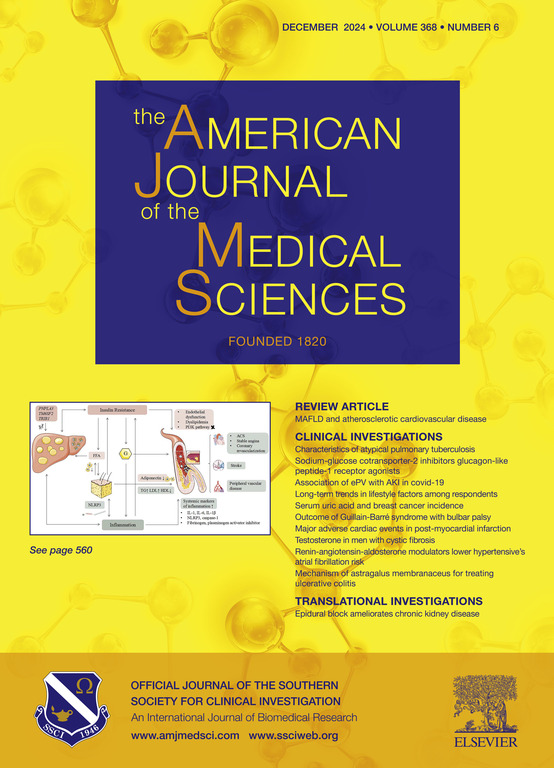长期机械通气患者血清渗透压与呼吸机相关性肺炎风险之间的关系:来自MIMIC-IV数据库的回顾性队列研究
IF 1.8
4区 医学
Q2 MEDICINE, GENERAL & INTERNAL
引用次数: 0
摘要
背景:本研究旨在探讨延长机械通气(PMV)患者血清渗透压与呼吸机相关性肺炎(VAP)风险及住院死亡率的关系。方法:本研究是一项回顾性队列研究,数据来源于重症监护医学信息市场数据库。根据血清渗透压临界值295 mmol/L将患者分为两组,参照组渗透压临界值低于295 mmol/L。主要结局变量为VAP的发生。次要终点是住院死亡率。Logistic和Cox回归模型分别评估了血清渗透压对VAP风险和住院死亡率的影响,并进行了后倾向评分匹配(PSM)的敏感性分析。结果:该研究共纳入6749例患者,第一和第三四分位数的中位随访时间为9.23(5.96,15.95)天。其中发生VAP 574例,死亡1143例。结论:通气开始时血清渗透压与PMV患者VAP发生风险及院内死亡率显著相关。本研究强调了维持PMV患者血清渗透压的重要性。本文章由计算机程序翻译,如有差异,请以英文原文为准。
Association between serum osmolality and the risk of ventilator-associated pneumonia in patients undergoing prolonged mechanical ventilation: a retrospective cohort study from MIMIC-IV database
Background
The study aimed to investigate the relationship between serum osmolality with the risk of ventilator-associated pneumonia (VAP) and in-hospital mortality in patients with prolonged mechanical ventilation (PMV).
Method
This study was a retrospective cohort study with data derived from the Medical Information Mart for Intensive Care database. Patients were categorized into two groups based on a serum osmolality cutoff of 295 mmol/L, with the reference group having values below 295 mmol/L. The primary outcome variable was the occurrence of VAP. The secondary outcome was in-hospital mortality. Logistic and Cox regression models assessed the effects of serum osmolality on VAP risk and in-hospital mortality, respectively, with sensitivity analysis conducted post-propensity score matching (PSM).
Results
The study included a total of 6749 patients a median follow-up duration along with the first and third quartiles of 9.23 (5.96, 15.95) days. Among the included patients, 574 cases of VAP occurred, and 1143 patients died in the hospital. The analysis revealed that compared to the reference group with serum osmolality <295 mmol/L, serum osmolality ≥295 mmol/L was associated with a higher risk of VAP occurrence [odds ratio (OR): 1.36, 95 % confidence interval (CI): 1.11–1.67] and a higher risk of in-hospital mortality [hazard ratio (HR): 1.22, 95 %CI: 1.06–1.40] (all P < 0.05). The analysis results after PSM matching were still significant (all P < 0.05).
Conclusions
Serum osmolality at the initiation of ventilation significantly correlated with the risks of VAP occurrence and in-hospital mortality in patients on PMV. This study highlights the importance of maintaining serum osmolality for patients undergoing PMV.
求助全文
通过发布文献求助,成功后即可免费获取论文全文。
去求助
来源期刊
CiteScore
4.40
自引率
0.00%
发文量
303
审稿时长
1.5 months
期刊介绍:
The American Journal of The Medical Sciences (AJMS), founded in 1820, is the 2nd oldest medical journal in the United States. The AJMS is the official journal of the Southern Society for Clinical Investigation (SSCI). The SSCI is dedicated to the advancement of medical research and the exchange of knowledge, information and ideas. Its members are committed to mentoring future generations of medical investigators and promoting careers in academic medicine. The AJMS publishes, on a monthly basis, peer-reviewed articles in the field of internal medicine and its subspecialties, which include:
Original clinical and basic science investigations
Review articles
Online Images in the Medical Sciences
Special Features Include:
Patient-Centered Focused Reviews
History of Medicine
The Science of Medical Education.

 求助内容:
求助内容: 应助结果提醒方式:
应助结果提醒方式:


